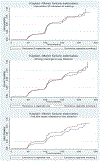Time to first report of signs of nicotine dependence among youth who use e-cigarettes and cigarettes in the United States: A nationally representative cohort study, findings from the Population Assessment of Tobacco and Health, 2013-2019
- PMID: 38432307
- PMCID: PMC12199532
- DOI: 10.1016/j.ypmed.2024.107924
Time to first report of signs of nicotine dependence among youth who use e-cigarettes and cigarettes in the United States: A nationally representative cohort study, findings from the Population Assessment of Tobacco and Health, 2013-2019
Abstract
Objective: To determine the time to first report of signs of nicotine dependence among youth exclusive e-cigarette users and compare this time to that for exclusive cigarette users.
Methods: Secondary analysis of data (Waves 1-5; 2013-2019) from the Population Assessment of Tobacco and Health was conducted. Youth never tobacco users in the United States who reported exclusive past-30-day (P30D) e-cigarette or cigarette use (n = 2940, N = 5,391,642) in at least one wave were included in the current analysis. Survival analysis was used to estimate the time to the first report of three nicotine dependence indicators (i.e., "use within 30 minutes of waking"; "cravings" and "really needing to use") following the first report of P30D use. Multivariable Cox proportional hazard models were used to estimate adjusted hazard ratios (aHR).
Results: There were no significant differences in the time to first report of "use within 30 minutes of waking" (aHR = 1.1, 95% CI = 0.87-1.40) and "cravings" (aHR = 1.09, 95% CI = 0.81-1.47) between exclusive P30D e-cigarette use and exclusive P30D cigarette use. However, compared to exclusive P30D e-cigarette use, the hazard of first reporting "really needing to use" tobacco was 39% (aHR 1.39; 95% CI: 1.05-1.84) times higher for those who reported exclusive P30D cigarette use after controlling for covariates.
Conclusion: Compared to exclusive P30D cigarette use, no differences in the time to first report of signs of nicotine dependence ("use within 30 minutes" and "cravings") were observed among exclusive P30D e-cigarette users. Policymakers and regulatory agencies should consider this evidence when assessing the abuse liability of e-cigarette products.
Keywords: Abuse liability; Cigarette use; E-cigarette use; Nicotine dependence.
Copyright © 2023. Published by Elsevier Inc.
Conflict of interest statement
Declaration of competing interest The authors declare the following financial interests/personal relationships which may be considered as potential competing interests. Dr. Harrell was an expert witness for the State of Minnesota in its case against Juul Labs and Altria. Dr. Mantey was a consultant for the State of Minnesota in its case against Juul Labs and Altria.” The other authors have no other potential conflicts of interest to disclose.
Figures


Similar articles
-
Does the time to nicotine dependence vary by internalizing symptoms for young people who use e-cigarettes? An analysis of the Population Assessment of Tobacco and Health (PATH) study, (Waves 1-5; 2013-2019).Addict Behav. 2024 Sep;156:108075. doi: 10.1016/j.addbeh.2024.108075. Epub 2024 May 25. Addict Behav. 2024. PMID: 38810488
-
Symptoms of nicotine dependence by e-cigarette and cigarette use behavior and brand: A population-based, nationally representative cross-sectional study.Drug Alcohol Depend. 2024 Feb 1;255:111059. doi: 10.1016/j.drugalcdep.2023.111059. Epub 2023 Dec 13. Drug Alcohol Depend. 2024. PMID: 38150895 Free PMC article.
-
Heated tobacco products for smoking cessation and reducing smoking prevalence.Cochrane Database Syst Rev. 2022 Jan 6;1(1):CD013790. doi: 10.1002/14651858.CD013790.pub2. Cochrane Database Syst Rev. 2022. PMID: 34988969 Free PMC article.
-
Smoking cessation medicines and e-cigarettes: a systematic review, network meta-analysis and cost-effectiveness analysis.Health Technol Assess. 2021 Oct;25(59):1-224. doi: 10.3310/hta25590. Health Technol Assess. 2021. PMID: 34668482
-
Sex differences in tobacco use, attempts to quit smoking, and cessation among dual users of cigarettes and e-cigarettes: Longitudinal findings from the US Population Assessment of Tobacco and Health Study.Prev Med. 2024 Aug;185:108024. doi: 10.1016/j.ypmed.2024.108024. Epub 2024 Jun 6. Prev Med. 2024. PMID: 38849056 Free PMC article.
References
Dataset Reference
-
- United States Department of Health and Human Services, November 5, 2019. National Institutes of Health. National Institute on Drug Abuse, and United States Department of Health and Human Services. Food and Drug Administration. Center for Tobacco Products. Population Assessment of Tobacco and Health (PATH) Study [United States] Restricted-Use Files. Inter-university Consortium for Political and Social Research [distributor]. 10.3886/ICPSR36231.v36. - DOI
MeSH terms
Grants and funding
LinkOut - more resources
Full Text Sources
Medical
Miscellaneous

